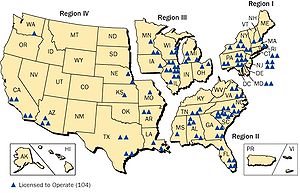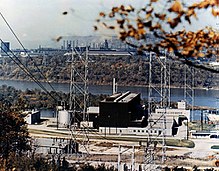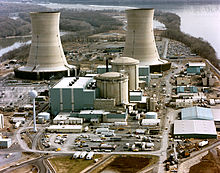Nuclear power in the United States: Difference between revisions
→Nuclear Organizations: bringing in comparative information |
→Resurgence: expanding |
||
| Line 33: | Line 33: | ||
As of April 2009, [[AmerenUE]] has suspended plans to build its proposed plant in Missouri because the state Legislature would not allow it to charge consumers for some of the project's costs before the plant's completion. [[The New York Times]] has reported that without that "financial and regulatory certainty," the company has said it could not proceed.<ref>[http://www.nytimes.com/cwire/2009/04/27/27climatewire-a-key-energy-industry-nervously-awaits-its-r-10677.html A key energy industry nervously awaits its 'rebirth']</ref> Previously, [[MidAmerican Energy Company]] decided to "end its pursuit of a nuclear power plant in Payette County, Idaho." MidAmerican cited cost as the primary factor in their decision.<ref>[http://www.reuters.com/article/companyNews/idUSN2957446620080129 MidAmerican drops Idaho nuclear project due to cost]</ref> |
As of April 2009, [[AmerenUE]] has suspended plans to build its proposed plant in Missouri because the state Legislature would not allow it to charge consumers for some of the project's costs before the plant's completion. [[The New York Times]] has reported that without that "financial and regulatory certainty," the company has said it could not proceed.<ref>[http://www.nytimes.com/cwire/2009/04/27/27climatewire-a-key-energy-industry-nervously-awaits-its-r-10677.html A key energy industry nervously awaits its 'rebirth']</ref> Previously, [[MidAmerican Energy Company]] decided to "end its pursuit of a nuclear power plant in Payette County, Idaho." MidAmerican cited cost as the primary factor in their decision.<ref>[http://www.reuters.com/article/companyNews/idUSN2957446620080129 MidAmerican drops Idaho nuclear project due to cost]</ref> |
||
The prospect of a "nuclear renaissance" has also revived debate about the [[nuclear waste]] issue. It is widely agreed that burying spent nuclear fuel deep underground is the best option for waste disposal, but no such long-term waste repositories yet exist.<ref> |
|||
{{cite web |
|||
| url= http://uk.reuters.com/article/domesticNews/idUKL2214163420080122 |
|||
| title= "Nuclear power rebirth revives waste debate" |
|||
| last= Motevalli | first= Golnar |
|||
| date= Jan 22, 2008 | publisher= [[Reuters]] |
|||
| accessdate= 2008-05-15 }} </ref><ref> |
|||
{{cite web |
|||
| url= http://www.sciam.com/article.cfm?id=a-nuclear-renaissance&print=true |
|||
| title= "A Nuclear Power Renaissance?" |
|||
|last= | first= |
|||
| date= April 28, 2008 |work= | publisher= ''[[Scientific American]]'' |
|||
| accessdate= 2008-05-15 }} </ref><ref> |
|||
{{cite web |
|||
| url= http://www.sciam.com/article.cfm?id=rethinking-nuclear-fuel-recycling |
|||
| title= Nuclear Fuel Recycling: More Trouble Than It's Worth |
|||
| last= von Hippel | first= Frank N. | authorlink= Frank N. von Hippel |
|||
| date= April 2008 |work= |publisher= ''Scientific American'' |
|||
| accessdate= 2008-05-15 }} </ref> |
|||
==Safety== |
==Safety== |
||
Revision as of 05:31, 27 May 2009


As of 2007 in the United States, there are 104 (69 pressurized water reactors and 35 boiling water reactors) commercial nuclear generating units licensed to operate, producing a total of 100,000 megawatts (electric), which is approximately 20% of the nation's total electric energy consumption. The United States is the world's largest supplier of commercial nuclear power.
History

President Dwight D. Eisenhower opened the Shippingport power plant atomic power station on May 26, 1958 as part of his Atoms for Peace program. Shippingport was the first commercial nuclear power plant built in the United States.
After the growth of nuclear power in the 1960s, the Atomic Energy Commission anticipated that more than 1,000 reactors would be operating in the United States by 2000. But by the end of the 1970s, it became clear that nuclear power would not grow nearly so dramatically, and more than 120 reactor orders were ultimately cancelled.[1]
The Three Mile Island accident has been the most serious accident experienced by the U.S. nuclear industry. Other accidents include those at the Davis-Besse Nuclear Power Plant, which has been the source of two of the top five most dangerous nuclear incidents in the United States since 1979, according to the Nuclear Regulatory Commission.[2]
To compare the historical safety record of civilian nuclear energy with the historical record of other forms of electrical generation, Ball, Roberts, and Simpson, the IAEA, and the Paul Scherrer Institut found in separate studies that during the period from 1970 - 1992, there were just 39 on-the-job deaths of nuclear power plant workers, while during the same time period, there were 6,400 on-the-job deaths of coal power plant workers, 1,200 on-the-job deaths of natural gas power plant workers and members of the general public caused by natural gas power plants, and 4,000 deaths of members of the general public caused by hydroelectric power plants.[3][4][5] In particular, coal power plants are estimated to kill 24,000 Americans per year, due to lung disease[6] as well as causing 40,000 heart attacks per year[7] in the United States. According to esteemed journal Scientific American, the average coal power plant emits more than 100 times as much radiation per year than a comparatively sized nuclear power plant does, in the form of toxic coal waste known as fly ash.[8]
A large number of plants have recently received 20-year extensions to their licensed lifetimes.
Several US nuclear power plants closed well before their design lifetimes, including Rancho Seco in 1989 in California, San Onofre Unit 1 in 1992 in California (units 2 and 3 are still operating), Zion in 1998 in Illinois and Trojan in 1992 in Oregon. Humboldt Bay in California closed in 1976, 13 years after geologists discovered it was built on a fault (the Little Salmon Fault). Shoreham Nuclear Power Plant never operated commercially as an authorized Emergency Evacuation Plan could not be agreed on due the political climate after the Three Mile Island and Chernobyl accidents.
Resurgence

2005 Poll:Blue represents those in favor of nuclear power, gray represents undecided, yellow represents opposed to nuclear power
In recent years,there has been a renewed interest in nuclear power in the US. This has been facilitated in part by the federal government with the Nuclear Power 2010 Program, which coordinates efforts for building new nuclear power plants,[9] and the Energy Policy Act which makes provisions for nuclear and oil industries.[10][11]
As of March 9, 2009, the U.S. Nuclear Regulatory Commission had received applications for permission to construct 26 new nuclear power reactors [12] with applications for another 7 expected.[13][14] Six of these reactors have actually been ordered.[15] In addition, the Tennessee Valley Authority petitioned to restart construction on the first two units at Bellefonte. However not all of this new capacity will necessarily be built, with some applications being made to keep future options open and reserving places in a queue for government incentives available for up to the first three plants based on each innovative reactor design.[13]
On August 26, 2008, it was reported that The Shaw Group and Westinghouse would construct a factory at the Port of Lake Charles at Lake Charles, Louisiana to build components for the Westinghouse AP1000 nuclear reactor. [16] On October 23, 2008, it was reported that Northrop Grumman and Areva were planning to construct a factory in Newport News, Virginia to build nuclear reactors.[17]

As of April 2009, AmerenUE has suspended plans to build its proposed plant in Missouri because the state Legislature would not allow it to charge consumers for some of the project's costs before the plant's completion. The New York Times has reported that without that "financial and regulatory certainty," the company has said it could not proceed.[18] Previously, MidAmerican Energy Company decided to "end its pursuit of a nuclear power plant in Payette County, Idaho." MidAmerican cited cost as the primary factor in their decision.[19]
The prospect of a "nuclear renaissance" has also revived debate about the nuclear waste issue. It is widely agreed that burying spent nuclear fuel deep underground is the best option for waste disposal, but no such long-term waste repositories yet exist.[20][21][22]
Safety
Regulation of nuclear power plants in the United States is done by the Nuclear Regulatory Commission, which divides the nation into 4 administrative divisions.
As of February 2009, the NRC requires that the design of new power plants ensures that the reactor containment would remain intact, cooling systems would continue to operate, and spent fuel pools would be protected, in the event of an aircraft crash. This is an issue that has gained attention since the Sept. 11, 2001, terrorist attacks. The regulation does not apply to the 104 commercial reactors now operating.[23]
Worker safety
The nuclear industry in the United States has maintained one of the best industrial safety records in the nation with respect to all kinds of accidents. For 2008, the industry hit a new low of 0.13 industrial accidents per 200,000 worker-hours.[24] This is improved over 0.24 in 2005, which was still a factor of 14.6 less than the 3.5 number for all manufacturing industries.[25] Private industry has an accident rate of 1.3 per 200,000 worker hours.[26]
Fuel Cycle

Uranium Mining
The United States has the 4th greatest uranium reserves in the world. Domestic production increased until 1980, after which it declined sharply due to low uranium prices. In 2001 the United States mined only 5% of the uranium consumed by its nuclear power plants. The remainder was imported, principally from Russia and Australia.[27] After 2001, however, uranium prices steadily increased, which prompted increased production and revived mines.
Uranium enrichment
The United States Enrichment Corporation (USEC) performs all enrichment activities for U.S. commercial nuclear plants, using 11.3 million SWUs per year at its Paducah, Kentucky site. The USEC plant still uses gaseous diffusion enrichment, which has now been proved to be inferior to centrifuge enrichment. However, the capital cost of such a plant is so high that the plant will go through a few more years of operation before being replaced by a modern centrifuge plant.
Currently, demonstration activities are underway at Oak Ridge National Laboratory for a future centrifugal enrichment plant. The new plant will be called the American Centrifuge Plant, which has an estimate cost of 2.3 billion USD.[28]
Reprocessing
US policy forbade nuclear reprocessing inside the country from 1976 to 1981. Since the GNEP was proposed, several reprocessing proposals have been made.
Disposal
In the United States, all power produced by nuclear energy pays a tax of 0.1 cents per kWh sold, in exchange for which the United States government takes responsibility for the high level nuclear waste. This tax has been collected since the beginning of the industry, but action by the government towards creation of a national geological repository was not taken until the 1990s and 2000s since all spent fuel is immediately stored in the spent fuel pools on site.
Recently, as plants continue to age, many of these pools have come near capacity, prompting creation of dry cask storage facilities as well. Several lawsuits between utilities and the government have also transpired over the cost of these facilities, because by law the government is required to foot the bill for actions that go beyond the spent fuel pool.
Since 1987, Yucca Mountain, in Nevada, had been the proposed site for the Yucca Mountain nuclear waste repository, but the project was shelved in 2009.[29]
Nuclear Organizations
Fuel Vendors
The following companies are those which have active Nuclear fuel fabrication facilities in the United States.[30] These are all light water fuel fabrication facilities because only LWRs are operating in the US. The US currently has no MOX fuel fabrication facilities, though Duke Energy has expressed intent of building one of a relatively small capacity.[31]
- Areva (formerly Areva NP) runs fabrication facilities in Lynchburg, Virginia and Richland, Washington. It also has a Generation III+ plant design, the Evolutionary Power Reactor, which it plans to market in the US.[32]
- Westinghouse operates a fuel fabrication facility in Columbia, South Carolina[33], which processes 1,600 metric tons Uranium (MTU) per year. It previously operated a nuclear fuel plant in Hematite, Missouri but has since closed it down.
- GE pioneered the BWR technology that has become widely used throughout the world. It formed the Global Nuclear Fuel joint venture in 1999 with Hitachi and Toshiba and later restructured into GE-Hitachi Nuclear Energy. It operates the fuel fabrication facility in Wilmington, North Carolina, with a capacity of 1,200 MTU per year.
Industry and Academic
The American Nuclear Society (ANS) scientific and educational organization that has academic and industry members. The organization publishes a large amount of literature on nuclear technology in several journals. The ANS also has some offshoot organizations such as North American Young Generation in Nuclear (NA-YGN).
The Nuclear Energy Institute (NEI) is an industry group whose activities include lobbying, experience sharing between companies and plants, and provides data on the industry to a number of outfits.
Anti-nuclear power groups
Some sixty anti-nuclear power groups are operating, or have operated, in the United States. These include: Abalone Alliance, Clamshell Alliance, Greenpeace USA, Institute for Energy and Environmental Research, Musicians United for Safe Energy, Nuclear Control Institute, Nuclear Information and Resource Service, Public Citizen Energy Program, Shad Alliance, and the Sierra Club.
See also
- Atomic Energy Act
- Anti-nuclear movement in the United States
- Atoms for Peace
- Energy policy of the United States
- Exelon
- List of nuclear reactors
- List of Prospective Nuclear Reactors
- Nuclear power debate
- Nuclear energy policy
- Nuclear Power 2010 Program
- Nuclear power whistleblowers
- Three Mile Island (book)
- United States-India Peaceful Atomic Energy Cooperation Act
- United States-Japan Joint Nuclear Energy Action Plan
References
- ^ Nuclear Power: Outlook for New U.S. Reactors p. 3.
- ^ Nuclear Regulatory Commission (2004-09-16). "Davis-Besse preliminary accident sequence precursor analysis" (PDF). Retrieved 2006-06-14.
{{cite web}}: Check date values in:|date=(help) and Nuclear Regulatory Commission (2004-09-20). "NRC issues preliminary risk analysis of the combined safety issues at Davis-Besse". Retrieved 2006-06-14.{{cite web}}: Check date values in:|date=(help) - ^ Research Report #20. United Kingdom: University of East Anglia. 1994.
{{cite book}}:|journal=ignored (help); Unknown parameter|coauthors=ignored (|author=suggested) (help) - ^ Hirschberg et al, Paul Scherrer Institut, 1996; in: IAEA, Sustainable Development and Nuclear Power, 1997
- ^ Severe Accidents in the Energy Sector, Paul Scherrer Institut, 2001.
- ^ "Senator Reid tells America coal makes them sick". 2008-07-10. Retrieved 2009-05-18.
- ^ "Deadly power plants? Study fuels debate". 2004-06-09. Retrieved 2009-05-18.
- ^ "Coal Ash Is More Radioactive than Nuclear Waste: By burning away all the pesky carbon and other impurities, coal power plants produce heaps of radiation". 2009-05-18. Retrieved 2009-05-18.
- ^ "The Daily Sentinel." Commission, City support NuStart. Retrieved on December 1, 2006
- ^ "US energy bill favors new build reactors, new technology". Nuclear Engineering International. 12 August 2005. Retrieved 2007-12-26.
- ^ Michael Grunwald and Juliet Eilperin (July 30, 2005). "Energy Bill Raises Fears About Pollution, Fraud Critics Point to Perks for Industry". Washington Post. Retrieved 2007-12-26.
{{cite news}}: Italic or bold markup not allowed in:|publisher=(help) - ^ Combined License Applications for New Reactors
- ^ a b Chris Gadomski (20 February 20 2009). "Will nuclear rebound?". Nuclear Engineering International. Retrieved 2009-03-11.
{{cite news}}: Check date values in:|date=(help) - ^ Map of new nuclear units
- ^ Shaw, Westinghouse sign nuke deal
- ^ Louisiana goes nuclear, cnn.com, August 26, 2008
- ^ Joint venture will build nuclear reactors in Newport News, The Virginian-Pilot, October 23, 2008
- ^ A key energy industry nervously awaits its 'rebirth'
- ^ MidAmerican drops Idaho nuclear project due to cost
- ^ Motevalli, Golnar (Jan 22, 2008). ""Nuclear power rebirth revives waste debate"". Reuters. Retrieved 2008-05-15.
- ^
""A Nuclear Power Renaissance?"". Scientific American. April 28, 2008. Retrieved 2008-05-15.
{{cite web}}: Italic or bold markup not allowed in:|publisher=(help) - ^
von Hippel, Frank N. (April 2008). "Nuclear Fuel Recycling: More Trouble Than It's Worth". Scientific American. Retrieved 2008-05-15.
{{cite web}}: Italic or bold markup not allowed in:|publisher=(help) - ^ Reactor Rule Made With 9/11 in Mind
- ^ Reuters. Nuclear Industry's Safety, Operating Performance Remained Top-Notch in '08, WANO Indicators Show. March 27, 2009.
- ^ Charles Fergus. Research Penn State. Are today's nuclear power plants safe?
- ^ [1]
- ^ Warren I Finch (2003) Uranium-fuel for nuclear energy 2002, US Geological Survey, Bulletin 2179-A.
- ^ "Uranium Enrichment — The American Centrifuge". USEC Inc. 2008. Retrieved 2008-05-15.
- ^ "Nuclear industry to fight Yucca Mountain bill".
- ^ :) "World Nuclear Fuel Facilities". WISE Uranium Project. last updated 14 May 2008. Retrieved 2008-05-15.
{{cite web}}: Check|url=value (help); Check date values in:|date=(help) - ^ "Duke Power Granted License Amendment by Nuclear Regulatory Commission To Use MOX Fuel". Duke Energy. March 03, 2005. Retrieved 2008-05-15.
{{cite web}}: Check date values in:|date=(help) - ^ "EPR: Generation III+ Performance" (PDF). 06 September 2007. Retrieved 2008-05-15.
{{cite web}}: Check date values in:|date=(help) - ^ Uranium Ash at Westinghouse Nuclear Fuel Plant Draws Fine | Environment News Service | Find Articles at BNET.com
External links
- World Nuclear Association
- U.S. Nuclear Power Plant Statistical Information
- World Nuclear Association: Nuclear energy in the world
- The Nuclear Energy Institute: The policy organization of the nuclear energy and technologies industry
- Nuclear power plant operators in the United States (SourceWatch).
